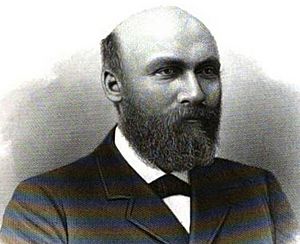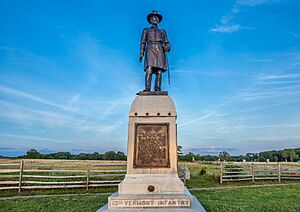Stephen F. Brown facts for kids
Quick facts for kids
Stephen Flavius Brown
|
|
|---|---|

Stephen F. Brown in 1891
|
|
| Born | April 4, 1841 Swanton, Vermont |
| Died | September 8, 1903 (aged 62) Swanton, Vermont |
| Place of burial |
Church Street Cemetery,
Swanton, Vermont |
| Allegiance | United States of America Union |
| Service/ |
Union Army |
| Years of service | 1862–1864 |
| Rank | |
| Unit | 13th Vermont Infantry 17th Vermont Infantry |
| Battles/wars | American Civil War |
| Other work | Attorney |
Stephen F. Brown (born April 4, 1841 – died September 8, 1903) was a brave officer in the Union Army during the American Civil War. He became famous for fighting in the Battle of Gettysburg with only a small axe.
Contents
Early Life and Joining the War
Stephen Flavius Brown was born in Swanton, Vermont, on April 4, 1841. He went to school in Swanton and became a teacher. He planned to go to the University of Vermont in the fall of 1862.
Instead of starting college, Brown joined the Civil War. He became a Private in Company K of the 13th Vermont Infantry Regiment. Soon after, he was chosen to be the company's First Lieutenant. His regiment, the 13th Vermont, was part of the 2nd Vermont Brigade. They worked in Maryland and Virginia in 1862 and 1863.
Heroism at the Battle of Gettysburg
In July 1863, Brown's brigade marched from Maryland to Gettysburg, Pennsylvania. On the way, Brown broke a rule about not falling behind. He also went past a guard to get water for his thirsty soldiers. Because of this, Brown was arrested and had his sword and pistol taken away. These were important symbols for an officer.
However, because the Battle of Gettysburg was about to begin, Brown was not held back. He was allowed to keep marching with his men.
Fighting with a Hatchet
When the 2nd Brigade arrived at Gettysburg, Brown wanted to prove himself. He found a small axe near his camp and charged into the battle. His men cheered him on. During the close-up fighting, he made a Confederate officer surrender. Brown took the officer's sword and pistol and made him a prisoner.
Wounded but Still Fighting
During the battle, Brown was hurt when an artillery shell exploded near him. He was helping a soldier who had lost a leg. The explosion caused hearing loss and other problems. But Brown refused to leave the battlefield. He told the doctor he would keep fighting unless his whole regiment was told to retreat.
Stopping Pickett's Charge
The 13th Vermont helped stop Pickett's Charge. This was a huge attack by Confederate soldiers. Units from the 2nd Vermont Brigade, led by George J. Stannard, moved out from the Union lines. They attacked the side of Pickett's men as they advanced. Stannard's quick action helped end Pickett's Charge and the Battle of Gettysburg.
Brown kept the captured sword and pistol for the rest of his service. The charges against him for breaking the "no straggling" rule were dropped.
Later Military Service
After his time with the 13th Vermont ended, Brown joined the army again. This time, he joined the 17th Vermont Infantry. He was promoted to Captain and became the commander of Company A.
In May 1864, Brown was wounded at the Battle of the Wilderness. A bullet hit his left shoulder while he was giving orders. His left arm had to be removed. Brown was discharged from the army in August 1864.
Life After the War
After the war, Brown went to Albany Law School and finished in 1868. He then moved to Chicago and became a successful lawyer. He also did well as a real estate investor.
During the Great Chicago Fire of 1871, he lost his law books, his office building, and other buildings he owned. But he was able to recover and continue his work.
In May 1882, a group called the U. S. Grant Grand Army of the Republic Post in Chicago honored Brown. They gave him a medal for his bravery at Gettysburg.
In 1891, Brown moved back to Swanton to take care of his parents. He stayed there after they passed away.
Brown was elected President of the Reunion Society of Vermont Officers in 1901. He was also active in other veteran groups like the Grand Army of the Republic (GAR) and the Military Order of the Loyal Legion of the United States (MOLLUS).
Death and Burial
Stephen F. Brown died in Swanton on September 8, 1903. He is buried at Church Street Cemetery in Swanton.
Family Life
Stephen F. Brown was the son of Samuel G. Brown (1816-1891) and Anne M. Crawford Brown (1817-1896). His father, Samuel G. Brown, also fought in the Civil War. He was in Company A of the 1st Vermont Infantry.
Stephen F. Brown's brother, Samuel G. Brown, Jr. (1842-1864), was a lieutenant in the 17th Vermont Infantry. He died in Washington, D.C. from typhoid fever.
In 1896, Brown married Mary N. McDonough (1851-1925) in Swanton.
Legacy and Memorials
There is a monument to the 13th Vermont on the Gettysburg battlefield. It has a statue of Stephen F. Brown on top. The War Department did not want him shown with his axe, because it was a symbol of him disobeying orders. So, the statue shows him with a sword at his side and an axe at his feet.
One part of the monument's base is dedicated to Brown. It says:
"The statue represents Stephen F. Brown, Co. K, who arrived on the field without a sword, but seized a camp hatchet, and carried it in the battle until he captured a sword from a Confederate officer. Persevering and determining like him were all the men of this regiment of Green Mountain Boys."
Brown gave the sword he captured at Gettysburg to the Vermont Historical Society.


